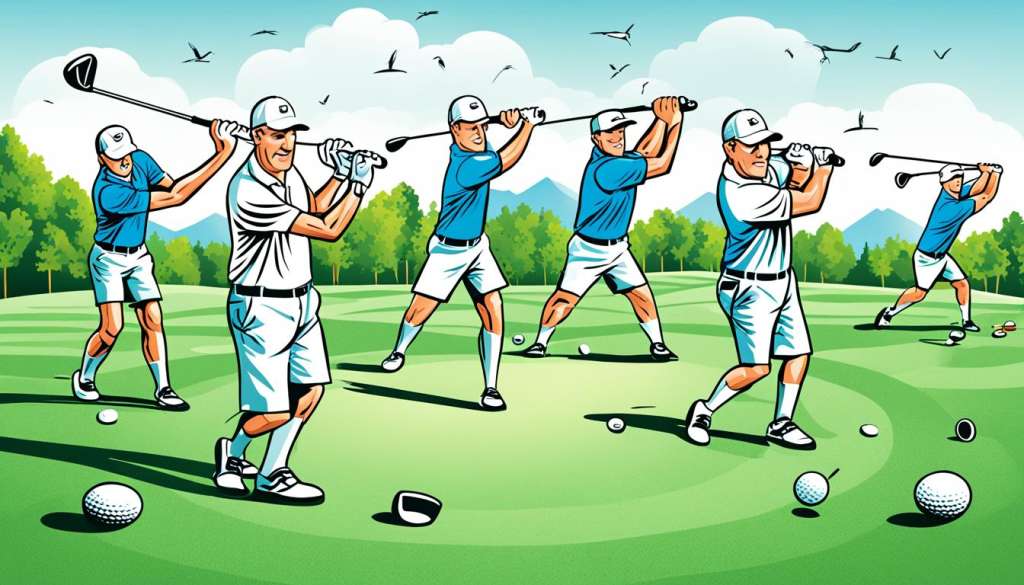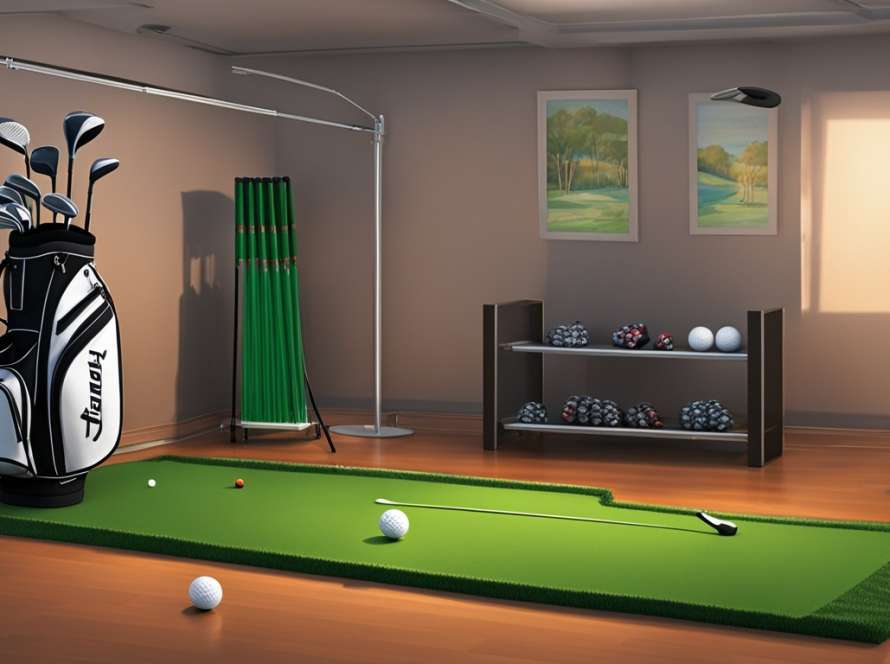You can boost your golf skills and cut your scores by focusing on key areas. This guide is perfect for both beginners and seasoned players wanting to get better. It will help you master golf.
Golf is simple to start with but hard to get really good at. Recently, 6 million new players joined, showing golf’s growing popularity. To improve your game, research courses, practice your drives, and learn about your clubs.
Work on your recovery shots to save strokes in tricky situations. Plan your next move before taking your shot. Know when to be bold and when to play safe. Using a golf handicap lets you track your progress and compete with others fairly.
With these tips and regular practice, you’ll see your scores drop and your game improve.
Understanding the Fundamentals of Golf Improvement
Golf improvement begins with learning the basics. To get better, you need to understand golf fundamentals, use proper technique, and practice regularly. Let’s look at the main parts that make up your golfing skills.
The Importance of Proper Technique
Having the right golf technique is key for doing well consistently. It means having the right grip, stance, and swing. A good technique lets you hit the ball accurately and with power. Work on these during practice to improve your game.
Setting Realistic Goals for Your Golf Game
It’s important to set clear golf goals. First, check where you are in your skills and see what you need to work on. Set goals for different parts of your game, like lowering your handicap or hitting the ball farther. Make sure your goals are tough but reachable.
The Role of Consistency in Skill Development
Practicing golf regularly is key to getting better over time. Make a routine that covers all parts of your game, like driving, iron shots, short game, and putting. Focus on practicing correctly and doing it often, not just how much you practice.
| Golf Skill Area | Practice Frequency | Focus Points |
|---|---|---|
| Driving | 2-3 times per week | Alignment, tempo, follow-through |
| Iron Play | 2-3 times per week | Ball striking, shot shaping, distance control |
| Short Game | 3-4 times per week | Chipping, pitching, bunker shots |
| Putting | 4-5 times per week | Reading greens, stroke consistency, distance control |
By focusing on these key areas of golf improvement, you’ll lay a solid foundation for your game. Remember, getting better takes time and patience. Stick to your golf goals and keep practicing to see lasting results on the course.
Analyzing Your Current Skill Level
To get better at golf, you need to know where you are. A detailed look at your skills shows where you can get better. Start by checking how you swing your golf club. This will show you any mistakes that might be slowing you down.
Many golfers use videos to check themselves. Watching your swing in slow motion helps you see what’s off. Look at your stance, grip, and how you follow through. These are key to a good golf swing.
Understanding your handicap is also key. It shows how good you are at golf. It lets you see how you’re doing over time and play fairly with others.
| Skill Level | Handicap Range | Typical Score (18 holes) |
|---|---|---|
| Beginner | 30+ | 100-120 |
| Average | 15-30 | 85-100 |
| Good | 5-15 | 75-85 |
| Expert | 0-5 | 70-75 |
Knowing yourself is the first step to getting better. Be honest about what you’re good at and what you’re not. This will help you focus your practice and improve your golf skills.
Developing a Pragmatic Plan for Improvement
Creating a golf improvement plan is key to boosting your skills. It means focusing on areas that need work, setting up a regular practice schedule, and getting help from a golf coach. Let’s look at how to make a plan that really helps your game.
Identifying Areas for Growth
First, check how you’re doing now. Keep track of your scores and see what you’re good at and what you’re not. Knowing this helps you make a plan for getting better.
Creating a Structured Practice Routine
Having a set practice schedule is crucial for getting better. Spend your practice time on different skills:
- Driving range: Work on full swings and ball striking
- Putting green: Focus on short putts and long lag putts
- Chipping area: Practice various short game shots
- Bunker practice: Improve sand play techniques
Set aside time for each skill based on what you need to work on. This way, you’ll improve all aspects of your game.
Incorporating Professional Guidance
Getting help from a golf coach can really speed up your progress. A good coach can:
| Benefit | Description |
|---|---|
| Technique Analysis | Identify and correct swing flaws |
| Personalized Drills | Provide targeted exercises for improvement |
| Mental Game Coaching | Enhance focus and on-course strategy |
| Equipment Advice | Ensure your clubs suit your playing style |
Think about both in-person lessons and online coaching to fit your schedule and how you learn best. Adding professional advice to your plan can make you improve faster and more reliably.
The Science of Motor Learning in Golf
Golf skill acquisition is a complex process of motor learning. Your brain and body work together to develop new movement patterns through practice and experience. This science can greatly improve your golf game.
- Block practice: Repeating the same skill multiple times
- Random/variable practice: Mixing different skills in unpredictable sequences
- Consequential practice: Simulating real game situations with outcomes
These methods help transfer skills from practice to the course, boosting your performance. Proprioception in golf is key. It’s your body’s way of sensing movement and position, helping you control your swing.
To get better at golf, focus on:
- Consistent practice routines
- Varied training scenarios
- Mental rehearsal techniques
- Feedback from coaches or technology
By using these motor learning principles, you’ll improve your golf swing. Remember, getting better takes time and patience. Stay committed to your practice, and you’ll see results on the course.
Mastering Golf Swing Mechanics
Improving your golf swing mechanics can really boost your game. A good golf swing mixes different parts to make you hit the ball far and accurately. Let’s look at the key parts of a great golf swing and how to get better at it.
Understanding the Components of a Proper Golf Swing
A good golf swing begins with the right setup. This means having the right grip, stance, and alignment. Your grip should be firm but not too tight, with your hands moving together. Stand with your feet shoulder-width apart, with your weight evenly spread.
Make sure your body lines up with the target. This helps you hit the ball straight.
Common Swing Faults and How to Correct Them
Many golfers face common swing mistakes that slow them down. These mistakes include:
- Swaying: Keep your lower body stable during the backswing
- Over-the-top swing: Focus on dropping the club into the slot on the downswing
- Early release: Maintain wrist hinge longer through impact
- Reverse pivot: Shift your weight properly to your back foot on the backswing
Fixing these mistakes can greatly improve your hitting and overall game.
Utilizing Technology for Swing Analysis
Today’s golf swing analysis tools give great insights into your swing. Launch monitors show how far the ball goes, how fast the club hits it, and how it spins. High-speed cameras let you see your swing in detail, frame by frame. These tools help spot what you need to work on and track your progress.
By working on your swing mechanics, fixing common mistakes, and using analysis tools, you can make your swing better. Remember, practice and patience are key to getting better over time.
Golf Skill Improvement Guide: Effective Practice Techniques
Improving your golf game is more than just hitting balls at the range. To really get better, you need to use effective practice techniques. Let’s look at some proven ways to boost your skills.

Block practice in golf means repeating a single shot or technique over and over. This helps you get your swing smooth and build muscle memory. For instance, you might hit 50 straight 7-iron shots to a target. It’s great for working on swing changes or getting a club down pat.
Random practice in golf makes you face real game situations. You switch between different clubs and shots, just like on the course. This helps improve your ability to adapt and make quick decisions. Try hitting a driver, then a wedge, followed by a putt – just like in a real game.
Consequential practice adds a bit of pressure to your training. You set up challenges with rewards or penalties to feel the stress of the game. For example, you might need to make three straight 5-foot putts before you’re done.
| Practice Type | Benefits | Best Used For |
|---|---|---|
| Block Practice | Builds muscle memory, refines technique | Swing changes, mastering specific clubs |
| Random Practice | Improves adaptability, decision-making | Preparing for real game scenarios |
| Consequential Practice | Enhances performance under pressure | Developing mental toughness |
Using these golf practice techniques will help you improve your skills and how you play on the course. Make sure to mix these methods in your practice for the best results.
Enhancing Your Mental Game
The mental game in golf is key to your success. Mastering your mind can make a big difference. Let’s look at how to prepare mentally and improve your game.
Developing focus and concentration
Improving your focus is crucial for steady play. Here are some tips:
- Practice mindfulness meditation to sharpen your attention
- Use pre-shot routines to center your thoughts
- Visualize successful shots before executing them
Managing on-course pressure
Handling pressure on the course is a skill. Here are some tips:
- Deep breathing exercises to calm nerves
- Positive self-talk to keep confidence up
- Focus on process goals, not just the outcome
Building confidence in your abilities
Confidence is vital in golf. Boost yours by:
- Celebrating small wins in practice and games
- Keeping a golf journal to track progress
- Setting realistic, achievable goals for each round
Improving your mental game takes time and effort. Add these strategies to your routine. You’ll see better focus, pressure management, and confidence on the course.
Improving Your Short Game
Your short game can greatly affect your golf performance. Mastering golf short game improvement techniques is key to lowering your scores. Let’s look at some effective strategies to boost your putting and chipping skills.

Putting is key to a strong short game. To improve your putting, try the “Eye of the Tiger” drill. Set up a circle of golf balls around the hole, each three feet away. Aim to sink these putts under pressure, with consequences for misses. This drill helps you focus and be consistent on the green.
Chipping skills are also vital for lowering scores. The “Up & Down” drill can greatly improve your chipping accuracy. Place several balls around the practice green at different distances. Aim to chip each ball onto the green and sink the putt in two strokes or less. This exercise mimics real game situations and helps you apply practice to the course.
To boost your golf short game:
- Practice regularly with purpose
- Focus on proper technique and alignment
- Try different clubs for varied shots
- Work on your touch and feel around the greens
- Visualize successful shots before you play them
A solid short game can make up for less-than-perfect long shots. By spending time on improving your putting and chipping, you’ll see your scores drop and your confidence rise on the course.
Course Management Strategies for Lower Scores
Learning how to manage a golf course can really boost your game and cut your scores. By understanding the layout, making smart choices, and adjusting to the conditions, you’ll play more strategically and with confidence.
Reading Greens and Understanding Course Layouts
It’s key to study the course before you start playing. Walk the greens to note the slopes and breaks. Look out for hazards and where you might land your shots. This info helps you plan your shots and steer clear of trouble, setting you up for success on each hole.
Making Smart Shot Selections
Pick your shots carefully, considering your skill level and the hole’s challenges. Sometimes, it’s better to lay up short of a hazard than to risk a tough shot. Golf shot selection is about finding a balance between being bold and cautious. Think about your approach to the green, including the pin’s position and wind direction.
Adapting to Different Playing Conditions
Weather and course conditions can change how you play. Adjust your strategy for wet fairways, windy days, or fast greens. Get better at reading golf greens in different conditions to improve your putting. By changing how you play, you’ll keep your game consistent even when faced with tough situations on the course.

